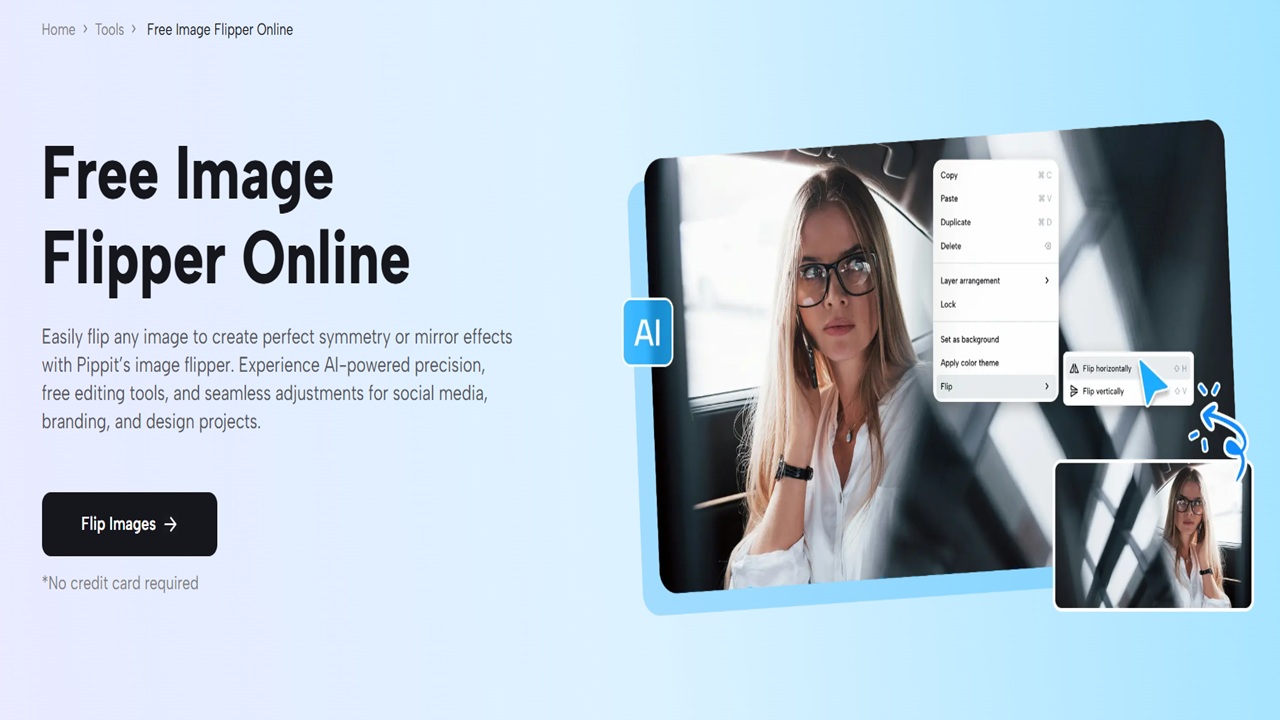All photographers, from professionals to hobbyists, recognize photography as an art form, and they pursue symmetrical compositions with visual appeal in their images. The tool of image flipping provides photographers with a strong capability to improve their photographic work. Image flipping enables users to generate symmetrical designs while solving orientation problems and discovering fresh visual aspects. The image flipper from Pippit AI provides photographers with a simple yet effective solution to improve their images through basic user interface operations. This article demonstrates how Pippit’s image flipping tools help photographers reach flawless results by improving their photography.
Essential for Photographers
Image flipping describes the technique of image reflection or rotation between vertical and horizontal directions. The horizontal flip operation exchanges the image sides between left and right to produce a mirrored effect. Vertical flipping transforms images by reflecting them across the horizontal axis. Such modifications enhance both the symmetry and composition elements in photographs. The process of flipping images enables you to create professional-looking results no matter what type of project you are working on, including social media content and marketing materials, and personal projects.
The Power of Symmetry in Photography
The innovative website for audio and video editing, Pippit AI, has a flipping picture feature that enables photographers to reach visual equilibrium, enhancing their work’s photographic appeal, especially when photographing products or still-life objects. The practice of flipping images is commonly used by photographers who work with architectural subjects and landscapes, as well as other objects requiring symmetrical balance. Your image becomes more appealing through flipping, which leads viewers to stay engaged for longer periods.
Process of Using Pippit AI Image Flipper
The Free Image Flipper tool from Pippit AI offers an interface that makes it easy for users to work with. The following simple instructions explain how to flip images with Pippit AI:
Upload Your Image
Open your Pippit account, then go to the “Image Studio” section. Users must choose the “Image Editor” from the quick tools menu after reaching the “Image Studio.” You can upload your image through two options: click on “Upload Image” or drag the file directly into the editor.
Flip Your Image
The photographer, after uploading their image, selects it and right-clicks to access the “Flip” option. A photographer can select “Flip Horizontal” or “Flip Vertical” from the options to produce their desired effect. The flip effect becomes visible immediately in the editor’s display, so you can evaluate its impact on your image’s layout.
Refine Your Image
The additional editing tools available in Pippit allow you to refine your photo after performing a flip operation. Use the image cropping tool to eliminate unnecessary sections, followed by brightness and contrast adjustments, and filter application for final touch-ups. The AI tools within Pippit automatically correct colors and remove backgrounds to help you create professional-looking results.
Download and Use
The photographer must click “Download” to save their image in their chosen resolution and format when they have finished your image flipping process. You can easily export your finished work through Pippit regardless of your intended use, which includes social media, marketing, or portfolio display.
Tips for Using Image Flipping in Your Photography
The image flipping tool provides quick results, but following these guidelines will help you maximize its potential:
Fix Orientation Issues
Photographers often encounter the issue where their images become reversed because of the front camera or smartphone configuration settings. The flipping effect becomes most apparent in selfie images because text becomes illegible and facial characteristics appear distorted. You can resolve orientation problems in your images through Pippit’s AI-powered flipper tool, which restores the original position before using it for professional purposes.
Balance Product Photography
The visual appeal and professional quality of product photographs depend heavily on maintaining consistent symmetrical elements. Using image flipping maintains visual consistency because it helps meet platform requirements or creative guidelines. The process of flipping product photos helps achieve desired style and tone requirements for both e-commerce and marketing purposes.
Enhance Fashion and Portrait Photography
Symmetry functions as an essential element in fashion photography because it creates visual appeal for subjects. Image flipping enables photographers to create symmetrical arrangements that enhance both model poses and clothing appearance while adding movement to the shot. This method appears often in the production of fashion reels and lookbooks, along with Instagram content.
Conclusion
The basic yet powerful image flipping method provides photographers with a method to completely transform their photographic output. The Free Image Flipper from Pippit provides photographers with an effortless solution to achieve perfect symmetry and correct image orientation, as well as add artistic mirror effects. Photographers can achieve professional-looking results through Pippit’s AI-powered features and intuitive tools, which minimize their work effort. The addition of image flipping to your workflow enables you to improve photo quality, thus creating more balanced and captivating images. Try Pippit’s Free Image Flipper to discover innovative ways of improving your photography right now.
